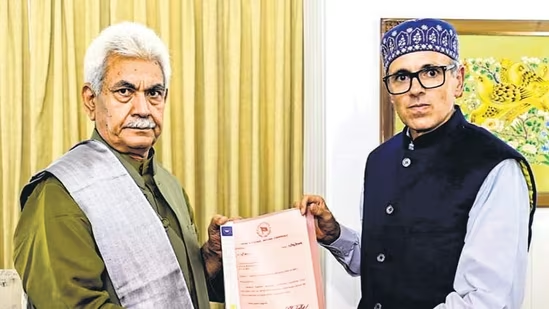14 october 2024 : On Friday, National Conference Vice President Omar Abdullah formally claimed the opportunity to form a new government in Jammu and Kashmir, following the lifting of President’s rule in the Union Territory. Central rule was established on October 31, 2019, when the former state was divided into the Union Territories of Jammu and Kashmir and Ladakh.
A notification signed by President Droupadi Murmu stated, “In exercise of the powers conferred by Section 73 of the Jammu and Kashmir Reorganisation Act, 2019 (34 of 2019) read with Articles 239 and 239A of the Constitution of India, the order dated the 31st October, 2019 in relation to the Union Territory of Jammu and Kashmir shall stand revoked immediately before the appointment of the chief minister under Section 54 of the Jammu and Kashmir Reorganisation Act, 2019.”
After a decade-long hiatus, assembly elections were held, resulting in the National Conference winning 42 seats, while its pre-poll allies, Congress and CPM, secured six and one seat, respectively. Additionally, five independent candidates and one AAP MLA have pledged their support to the National Conference, bringing the alliance’s total to 55 seats.
Omar Abdullah is expected to be sworn in as the Chief Minister of the Union Territory, with the Assembly session scheduled for Wednesday. He previously served as Chief Minister from 2009 to 2014 in an NC-Congress alliance government, during which Jammu and Kashmir had the status of a full state and the Chief Minister had broader powers.
The region has been without an elected government since June 2018 when the Bharatiya Janata Party (BJP) withdrew its alliance with the Peoples’ Democratic Party (PDP), leading to Mehbooba Mufti’s resignation as Chief Minister. Following this, the then-governor, Satya Pal Malik, dissolved the Jammu and Kashmir Legislative Assembly on November 28, 2018, shortly after Mufti sought support from Congress and the National Conference to form a government.
On December 19, 2018, President Ram Nath Kovind issued a notification implementing President’s rule in J&K under Article 356 of the Indian Constitution. However, since Article 356 does not apply to Union Territories, when Jammu and Kashmir became a Union Territory on October 31, 2019, President’s rule in the undivided region was lifted, but central rule continued indefinitely under the Lieutenant Governor (LG).
Changes for the Union Territory of Jammu and Kashmir
The lifting of President’s rule enables the formation of a new government and the appointment of a new Chief Minister, resulting in a cabinet that will govern the Union Territory and address local concerns.
Elected representatives will regain authority over local governance, thereby decreasing direct intervention from the central government.
The legislative assembly will reconvene, allowing elected officials to discuss and pass laws pertinent to Jammu and Kashmir.
While the assembly can deliberate on financial matters, all grants and appropriations must be approved by the LG.
The Lieutenant Governor will retain executive authority over essential areas such as police, public order, and land management.

